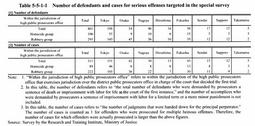| Previous Next Index Image Index Year Selection | |
|
|
In Chapter 3 and 4 , we gave an outline of the changing nature of heinous offenses (changes of characteristics) and the problems of juvenile robbery offenders, the number of which has been increasing significantly compared to other heinous offenders. In this chapter, we will introduce several categories of homicides and robberies in which offenders received the most severe punishments the death penalty or life imprisonment (hereinafter, referred to as "serious offenses"), and will analyze actual circumstances and trends in recent years in these serious offenses based on the related special survey.
The number of these serious offenses accounts for a small proportion of total heinous offenses. However, these offenses often strongly reflect and represent the characteristics, changes, and problems of heinous offenses that we analyzed in the previous chapters. Moreover, these offenses sometimes clarify serious criminal phenomenon and problems that are not easily revealed from the observation of the overall criminal condition. Therefore, our analysis is considered to be useful for grasping the overall picture, of heinous offenses. In addition, among the heinous offenses that occurred in recent years, the serious offenses subject to the most severe punishments often draw the attention of the public through news reports, etc. Therefore, it is very important to inform the public of the characteristics of such offenses. With the above objectives, we focused on heinous offenses for which a sentence of death or imprisonment with labor for life had been demanded by prosecutors at district courts nationwide during the five years from January 1, 1998, to December 31, 2002. In particular, we focused on all of the cases for which the judgment of the court of the first instance had been delivered during that period (for the purpose of examining recent trends, we only included cases where homicide or robbery had been committed since January 1, 1992), and conducted a variety of surveys from diverse standpoints, including the offenders' profile, motivation/background, ways of committing offenses, results of the offenses, and attitude at public trial. Then, we classified these cases into 2 categories-the homicide group and the robbery group (the robbery group includes those who committed homicide on the occasion of robbery, robbery resulting in death or bodily injury, robbery, or rape on the occasion of robbery; the homicide group includes offenses other than the above), analyzing each of them. Table 5-5-1-1 shows the number of cases and defendants targeted in the survey. Table 5-5-1-1 Number of defendants and cases for serious offenses targeted in the special survey |
